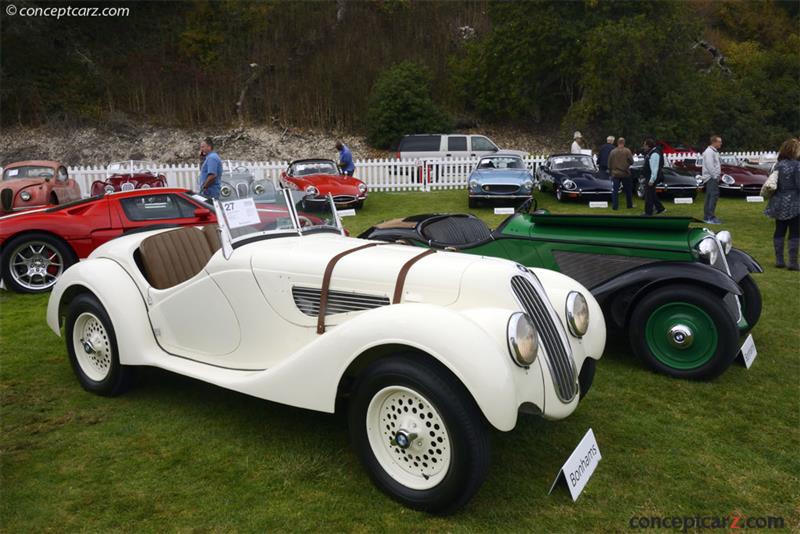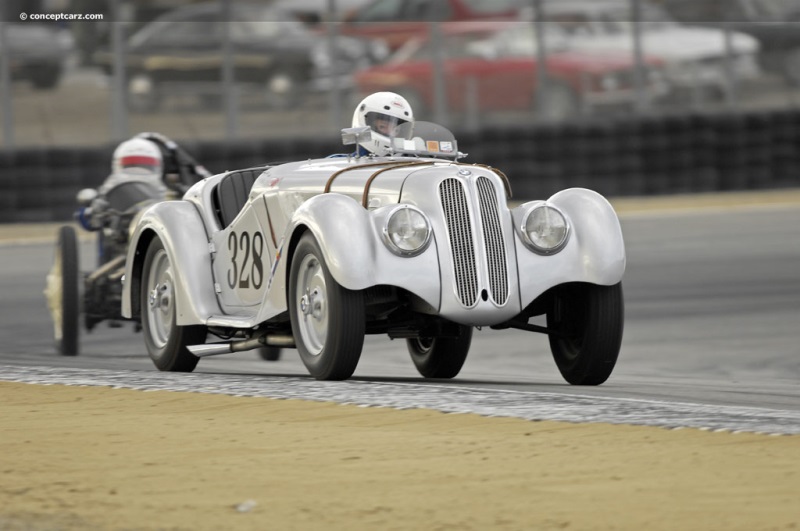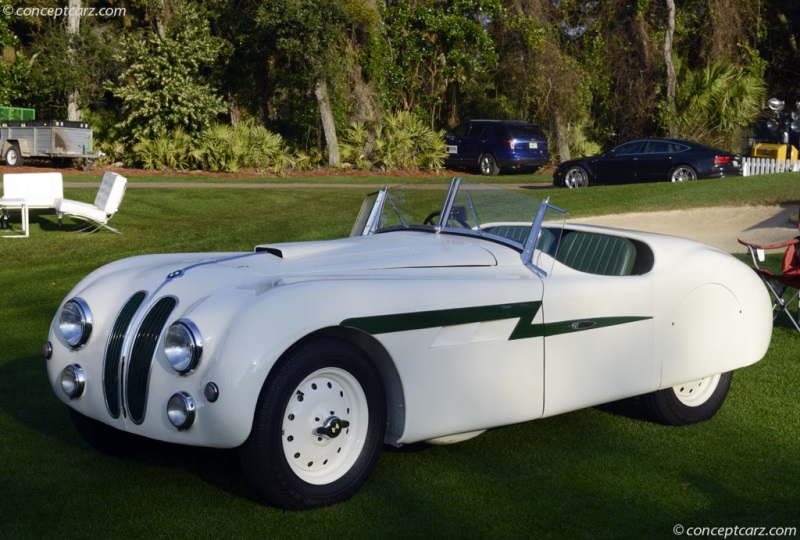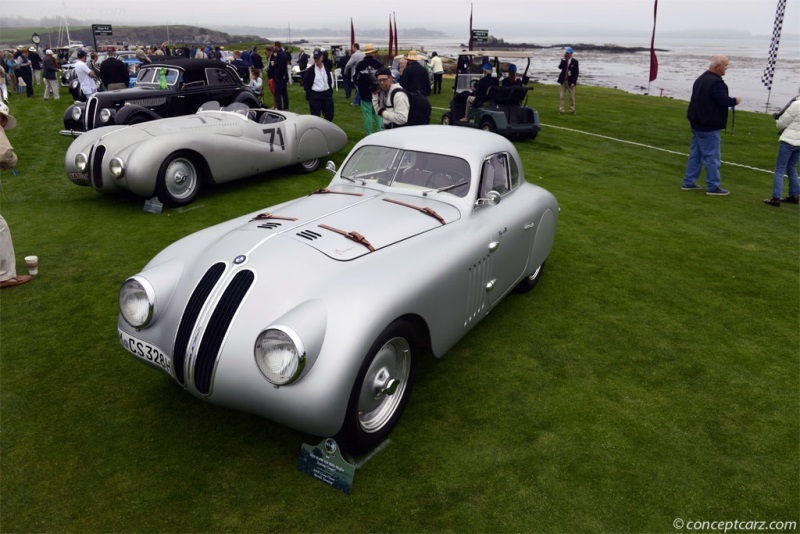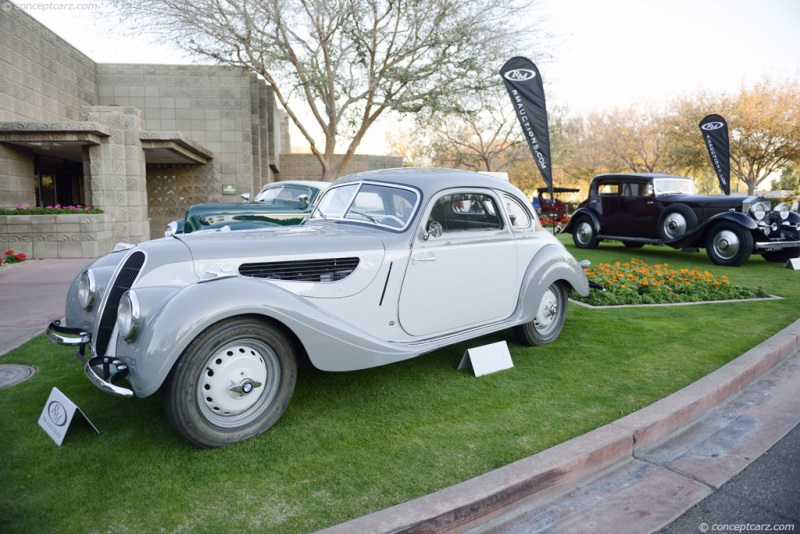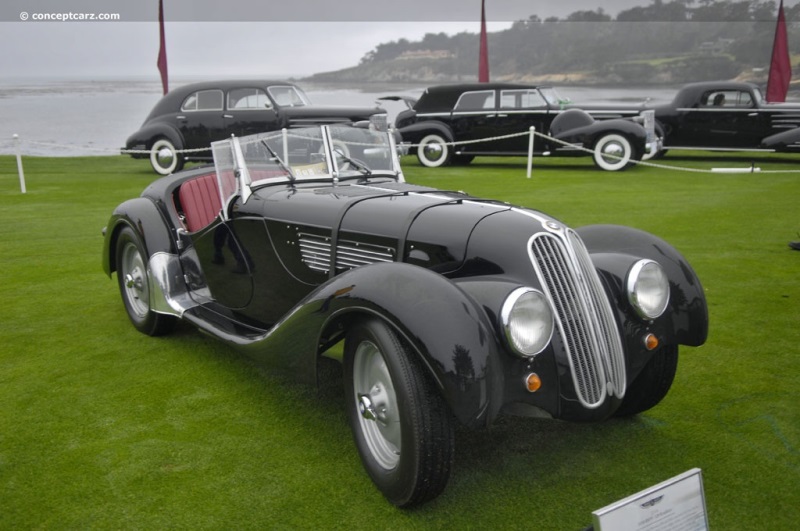History
In 1936, BMW (Bavarian Motor Works) introduced the stylish and aerodynamic Type 328. The design of the vehicle, courtesy of Fritz Fiedler, provided excellent handling and the inline-six-cylinder engine produced excellent performance. The engine featured a cast-iron block and dual overhead valves per cylinder bank. The total output was around 80 horsepower. The engine was placed in the front and provided power to the rear wheels. The body panels were constructed of a lightweight alloy. The chassis was comprised of a tubular space frame construction.
As was sometimes the custom with many early European vehicles, the coachwork was handled by a custom coachbuilder. Examples exist where the famous Figoni et Falaschi Carrosserie of Paris, France outfitted the vehicle with exquisite designs.
The vehicle was very successful on the racing circuit winning such races as a class win at the Mille Miglia in 1938. In 1940 it was first in class and first overall. At the 1939 Le Mans 24 Hour race it place fifth overall and first in class. A 328 won the RAC Rally in 1939.
During the close of the 1940's, Jaguar introduced the XK-120, a vehicle that was similar in design to the BMW Type 328.
By Daniel Vaughan | Sep 2006
As was sometimes the custom with many early European vehicles, the coachwork was handled by a custom coachbuilder. Examples exist where the famous Figoni et Falaschi Carrosserie of Paris, France outfitted the vehicle with exquisite designs.
The vehicle was very successful on the racing circuit winning such races as a class win at the Mille Miglia in 1938. In 1940 it was first in class and first overall. At the 1939 Le Mans 24 Hour race it place fifth overall and first in class. A 328 won the RAC Rally in 1939.
During the close of the 1940's, Jaguar introduced the XK-120, a vehicle that was similar in design to the BMW Type 328.
By Daniel Vaughan | Sep 2006
The BMW 328 Roadster was a compact two-seater with leather straps adorning the front hood and a very potent force in the racing scene. It was powered by a lightweight six-cylinder engine bred from the success of its siblings and fitted to a short-wheelbase chassis, the 328's was very sporty, culminating with a win at the 1940 Mille Miglia.
Racing has always been important; it perfects the breed and promotes the brand. BMW's six-cylinder engine from the 1934 315 became the basis for 328. The 1.5-liter version had modest success in its racing class, but more was required to keep it competitive in the under the 2-liter category. A new, larger version of the engine was developed, resulting in an increase in horsepower to 55 bhp. This was an increase of 15hp. The new engine was fitted to a chassis and dubbed the 319. Visually, few aesthetic differences existed between the 315 and the 319. They were nearly identical, except under-hood.
In 1936, the 326 was introduced. It was a larger vehicle to the 315 but had 55 horsepower. The increase in horsepower and size gave it only a slight increase in performance over its 315 siblings. The following year, a two-seater cabriolet version was introduced, called the 327. This, in a similar guise to the 319, was unable to match its performance resulting in slow sales.
BMW responded by improving its engine, creating a new cylinder head, and modifying the valve train. The valve train was very similar to other marque's of the day, such as Riley and Talbot, where a lateral camshaft actuated the inlet and outlet valves with push-rods and rocker arms. Installed opposite to one another, with each on either sides of the engine, resulting in a hemispherical combustion chamber. These modifications gave the engine a significant boost in power, up by 25bhp over its predecessor, to 80bhp.
In 1936, the engine made its debut in the 328 at the Eiffel Rennen race. It was piloted by Ernst Henne and easily won the 2-liter class. On its inaugural race, the engine had proven to be reliable and powerful. Privateers took notice, and help make the vehicle both a sales success and a dominant force on the racing circuit.
The 328 was given drum brakes in both front and rear, a rack-and-pinon steering setup, and a tubular steel chassis. The lightweight aluminum body concealed the 2-liter, six-cylinder engine and its available 80 horsepower. The engine had a cast-iron block and aluminum heads with two-valves per cylinder. The front suspension featured swing axles and transverse leaf springs while in the rear there was a live axle and semi-elliptic leaf springs. The engine was mated to a ZF four-speed manual gearbox and sent power to the rear wheels. The standard-wheelbase size for the roadsters was 94.5 inches and a length of 153.5 inches. With an overweight of around 1800 lbs, the pre-War BMW 328 was very lightweight, nimble, and fast.
The 328 came in various configurations, such as a roadster and cabriolets. Custom coachbuilders such as Wendler and Drauz, and Glaeser created many of the cabriolet versions, noted for their luxurious amenities and elegant style. The Roadster bodies were the standard configuration with most assembled by the factory. Touring was tasked with creating purpose-built versions for the 1939 24 Hours of LeMans. The 'Superlegerra' (Meaning lightweight) construction methods were used coupled with a design meant to minimize drag. The result was astonishing, with a fifth-place overall finish and an outright victory in the two-liter class.
For 1940, BMW turned their sights on the grueling Mille Miglia race. Five cars were entered and one emerged in first place. Baron Fritz Huschke von Kanstein drove a special-bodied BMW 328 Coupe to victory. It featured a streamlined body with aluminum and magnesium alloy construction. Overall, the 328's finished in first, third, fifth, and sixth at the 1940 Mille Miglia. The 3rd, 5th, and 6th positions were captured by roadster-bodied 328s. The final 328 version entered in the race was a limousine-bodied car that was tailored for racing and given aerodynamic features courtesy of Professor Wunibald Kamm. It was driven by Count Lurani but failed to finish the race.
During the production lifespan of the 328, BMW and Frazer Nash both produced 328s. BMW supplied the British-based Frazer Nash Company with rolling chassis. Total production for all 328 models was around 426 with around half still in existence.
The 328 engine would be used in the post-war Era, by BMW, Bristol, and AC in various forms. It would be used to power such cars as Cooper Bristols Formula 2 racers.
By Daniel Vaughan | Jul 2008
Racing has always been important; it perfects the breed and promotes the brand. BMW's six-cylinder engine from the 1934 315 became the basis for 328. The 1.5-liter version had modest success in its racing class, but more was required to keep it competitive in the under the 2-liter category. A new, larger version of the engine was developed, resulting in an increase in horsepower to 55 bhp. This was an increase of 15hp. The new engine was fitted to a chassis and dubbed the 319. Visually, few aesthetic differences existed between the 315 and the 319. They were nearly identical, except under-hood.
In 1936, the 326 was introduced. It was a larger vehicle to the 315 but had 55 horsepower. The increase in horsepower and size gave it only a slight increase in performance over its 315 siblings. The following year, a two-seater cabriolet version was introduced, called the 327. This, in a similar guise to the 319, was unable to match its performance resulting in slow sales.
BMW responded by improving its engine, creating a new cylinder head, and modifying the valve train. The valve train was very similar to other marque's of the day, such as Riley and Talbot, where a lateral camshaft actuated the inlet and outlet valves with push-rods and rocker arms. Installed opposite to one another, with each on either sides of the engine, resulting in a hemispherical combustion chamber. These modifications gave the engine a significant boost in power, up by 25bhp over its predecessor, to 80bhp.
In 1936, the engine made its debut in the 328 at the Eiffel Rennen race. It was piloted by Ernst Henne and easily won the 2-liter class. On its inaugural race, the engine had proven to be reliable and powerful. Privateers took notice, and help make the vehicle both a sales success and a dominant force on the racing circuit.
The 328 was given drum brakes in both front and rear, a rack-and-pinon steering setup, and a tubular steel chassis. The lightweight aluminum body concealed the 2-liter, six-cylinder engine and its available 80 horsepower. The engine had a cast-iron block and aluminum heads with two-valves per cylinder. The front suspension featured swing axles and transverse leaf springs while in the rear there was a live axle and semi-elliptic leaf springs. The engine was mated to a ZF four-speed manual gearbox and sent power to the rear wheels. The standard-wheelbase size for the roadsters was 94.5 inches and a length of 153.5 inches. With an overweight of around 1800 lbs, the pre-War BMW 328 was very lightweight, nimble, and fast.
The 328 came in various configurations, such as a roadster and cabriolets. Custom coachbuilders such as Wendler and Drauz, and Glaeser created many of the cabriolet versions, noted for their luxurious amenities and elegant style. The Roadster bodies were the standard configuration with most assembled by the factory. Touring was tasked with creating purpose-built versions for the 1939 24 Hours of LeMans. The 'Superlegerra' (Meaning lightweight) construction methods were used coupled with a design meant to minimize drag. The result was astonishing, with a fifth-place overall finish and an outright victory in the two-liter class.
For 1940, BMW turned their sights on the grueling Mille Miglia race. Five cars were entered and one emerged in first place. Baron Fritz Huschke von Kanstein drove a special-bodied BMW 328 Coupe to victory. It featured a streamlined body with aluminum and magnesium alloy construction. Overall, the 328's finished in first, third, fifth, and sixth at the 1940 Mille Miglia. The 3rd, 5th, and 6th positions were captured by roadster-bodied 328s. The final 328 version entered in the race was a limousine-bodied car that was tailored for racing and given aerodynamic features courtesy of Professor Wunibald Kamm. It was driven by Count Lurani but failed to finish the race.
During the production lifespan of the 328, BMW and Frazer Nash both produced 328s. BMW supplied the British-based Frazer Nash Company with rolling chassis. Total production for all 328 models was around 426 with around half still in existence.
The 328 engine would be used in the post-war Era, by BMW, Bristol, and AC in various forms. It would be used to power such cars as Cooper Bristols Formula 2 racers.
By Daniel Vaughan | Jul 2008
Similar Automakers
Similarly Sized Vehicles
from 1939
1939 BMW 328 Vehicle Profiles
Recent Vehicle Additions
Related Automotive News

THE 20TH ANNUAL AMELIA CONCOURS HONORS THE ORIGINAL 'ULTIMATE DRIVING MACHINE', BMW's IMMORTAL 328
. . . a long legged proper sports car. Sir Stirling Moss
The 20th annual Amelia Island Concours dElegance will showcase the legend and legacy of the car that set BMW on its path to become known as the ultimate driving machine.
...

Alpine At The Geneva Motor Show
Alpine unveils three new versions of the A110
Two new A110 versions unveiled for the road one new A110 for the racetrack
Pure and Légende production series versions with distinct characters
New colour options and wheel designs
GT4 racing...

Alpine Passion Through The Years At Retromobile
Retromobile set to play host to six classic Alpine models
The Alpine Vision show car will also be on display as a symbolic bridge between the brands past and future
Groupe Renault is pleased to confirm Alpines participation in the 42nd Retromobi...

1938 Alfa Romeo 8C 2900B Touring Spyder Epitomizes The Elegance at Hershey
HERSHEY, PA - The theme for this years Elegance at Hershey is Celebration of Speed. After deciding upon the overall theme, One of the first decisions we made was to choose an automobile that epitomized that concept, stated Steve Moskowitz,...

GENERAL MOTORS GALORE AT MECUM KISSIMMEE 2016
69 Trans Am Convertibles, 69 ZL1s and Featured Corvettes at Auction, Jan. 15-24
Walworth, Wis. – Jan. 12, 2016 – As the worlds largest collector-car auction featuring 3,000 vehicles, Mecum Kissimmee is unequaled in its variety of mak...

THE McLAREN 675LT: POWER. A BEAUTIFUL THING
Light weight, optimised aerodynamics, increased power, track-focused dynamics and driver engagement – all characteristics of a McLaren Longtail
0-100 kmh (62 mph) in 2.9 seconds 0-200 kmh (124 mph) in 7.9 seconds top speed of 330kmh (205 mph...




























